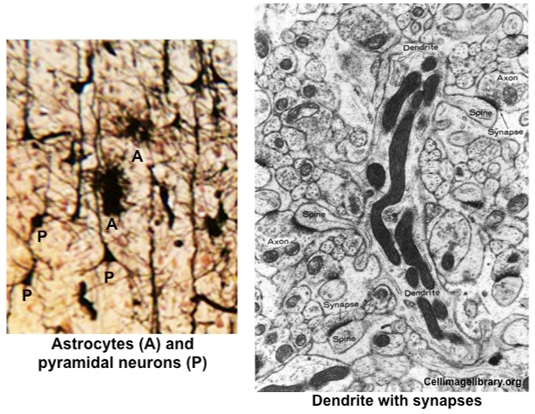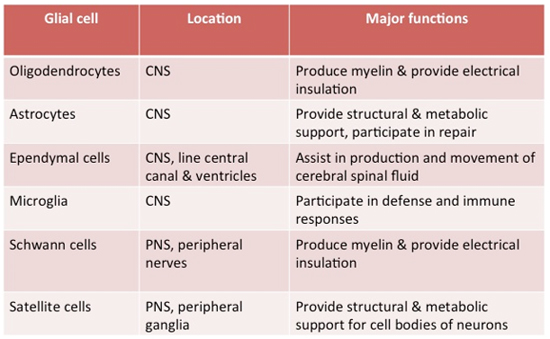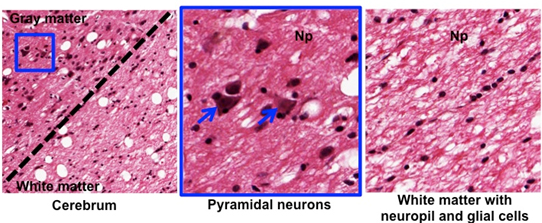|
Cells and general organization of
the Central Nervous System (CNS)
First, review gross and microscopic
features of CNS tissue: cerebrum, cerebellum, spinal cord, and
meninges. This will help orient you to what you will be looking
for on the slides in this unit. We’ll start with the cerebrum.
Examine the images below and sections of
cerebral cortex with low
power, noting the differences between white and gray matter. Gray
matter, the thick surface layer where most synapses occur (see TEM
image below), is composed of the cell bodies of six types of
neurons, dendrites, and glial cells such as astrocytes and
microglial cells (study the table below for more information about
glial cells). The most recognizable of the neurons are the pyramidal
neurons with their large, distinctive pyramid-shaped cell bodies.
Cerebral cortex neurons integrate sensory information and stimulate
voluntary motor functions. In contrast, the white matter consists
mainly of myelinated axons and glial cells, such as the
oligodendrocytes that produce myelin, as well as astrocytes and
microglia. Few neuronal cell bodies are present in the white
matter. with low
power, noting the differences between white and gray matter. Gray
matter, the thick surface layer where most synapses occur (see TEM
image below), is composed of the cell bodies of six types of
neurons, dendrites, and glial cells such as astrocytes and
microglial cells (study the table below for more information about
glial cells). The most recognizable of the neurons are the pyramidal
neurons with their large, distinctive pyramid-shaped cell bodies.
Cerebral cortex neurons integrate sensory information and stimulate
voluntary motor functions. In contrast, the white matter consists
mainly of myelinated axons and glial cells, such as the
oligodendrocytes that produce myelin, as well as astrocytes and
microglia. Few neuronal cell bodies are present in the white
matter.


Under higher power, examine this section of the
cerebral
cortex and
identify: neuronal cell bodies, neuropil (Np, axons and dendrites of
neurons), and glial cells (oligodendrocytes and astrocytes). and
identify: neuronal cell bodies, neuropil (Np, axons and dendrites of
neurons), and glial cells (oligodendrocytes and astrocytes).

On the
slide of cerebral cortex and in the images below, identify structural features of neurons
that are visible in the light microscope, including their prominent
nucleoli and chromatophilic Nissl substance (RER). These features
are typical of metabolically active cells that are producing
abundant proteins.
and in the images below, identify structural features of neurons
that are visible in the light microscope, including their prominent
nucleoli and chromatophilic Nissl substance (RER). These features
are typical of metabolically active cells that are producing
abundant proteins.

The meninges include three connective tissue
layers (pia, dura, and arachnoid mater) that surround and protect
the CNS. On the cerebral cortex section, examine the edge showing remnants of the innermost meningial layer, the pia mater, and note the intracerebral
penetration of blood vessels from this surface. Pia mater covers
arteries and veins in the brain.
section, examine the edge showing remnants of the innermost meningial layer, the pia mater, and note the intracerebral
penetration of blood vessels from this surface. Pia mater covers
arteries and veins in the brain.
Clinical note: The meninges are the
site of various medical problems, such as meningitis, subdural
hematomas, subarachnoid hemorrhage, and meningiomas.
Cerebellum
and spinal cord. |